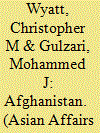|
|
|
Sort Order |
|
|
|
Items / Page
|
|
|
|
|
|
|
| Srl | Item |
| 1 |
ID:
179341


|
|
|
|
|
| Summary/Abstract |
This article is about the interplay of defining characteristics in Afghanistan that led to the fall of King Amanullah in 1929. Previously, this has been done by looking at the reforms, tribal society and the ulema, the community of scholars, but the prism through which we examine Amanullah's downfall is Mahmud Tarzi's grouping together of ‘Din, Daulat, Watan, Millat' (Religion, State, Homeland (or Fatherland), Nation). The ideals informing this grouping, as well as the concepts themselves, were key factors underpinning Amanullah’s reform agenda. Where Tarzi wrote of these factors as integrative and functioning together, a perspective taken uncritically by many commentators, we argue here that, as concepts in governance intended to unify the country, they acted as the exact opposite; that they sparked off each other, contradicted each other, and undermined each other in the context of the period. Understanding this explains much of the fragmentation Afghanistan suffered in the 1920s and suggests a structural process of causation for the fall of Amanullah.
|
|
|
|
|
|
|
|
|
|
|
|
|
|
|
|
| 2 |
ID:
148021


|
|
|
|
|
| Summary/Abstract |
In the imaginations of many, war in British India had its focus on the North-West Frontier and was fought against the tribes of that region. However, British thinking about Indian defence involving Afghanistan underwent tremendous change over the period under consideration. British plans to meet a Russian invasion on the Kabul-Kandahar Line in 1904 resembled those of any other Nineteenth Century Imperial campaign, with numbers of infantry and cavalry still being thought of and referred to as bayonets and sabres. Twenty years later, heavily influenced by the experiences of the Great War in the region and the Third Afghan War and associated operations, the calculus was different with logistics changed by motor vehicles and the introduction of what today are referred to as force multipliers, such as aeroplanes and machine guns. It was over this period that warfare as fought and conceptualised by men like Napoleon gave way to modern practices familiar to us today.
|
|
|
|
|
|
|
|
|
|
|
|
|
|
|
|
|
|
|
|
|